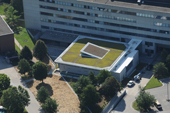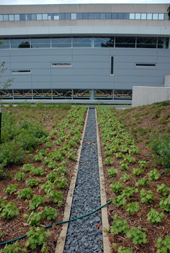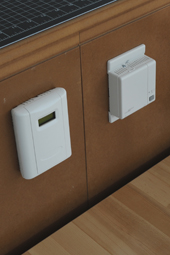AMES, Iowa --- The King Pavilion addition to the Iowa State University College of Design has been awarded LEED Platinum certification by the U.S. Green Building Council (USGBC). It is the first higher education building in Iowa to achieve LEED Platinum status.
LEED ® is USGBC's rating system for designing and constructing the greenest, most energy-efficient and high-performing buildings. Platinum is the highest rating given.
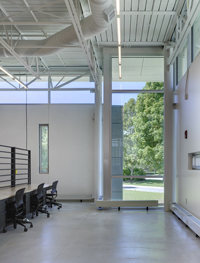
"We are delighted to have the King Pavilion receive LEED Platinum certification," said ISU President Gregory Geoffroy. "The King Pavilion stands as a testament to the commitment that Iowa State University has made to becoming a model 'green' university, in our daily operations as well as in our teaching, research and outreach programs."
The King Pavilion was designed by RDG Planning & Design, Des Moines. Others on the project team included Conservation Design Forum, Elmhurst, Ill.; Charles Curt, Engineering Economics Inc., Red Wing, Minn.; Holabird & Root, Rochester, Minn.; Charles Saul Engineering, Des Moines; Stecker-Harmsen, Ames, and The Weidt Group, Minnetonka, Minn.
The LEED (Leadership in Energy and Environmental Design) Green Building Rating System offers four certification levels for new construction (NC) - Certified, Silver, Gold and Platinum - that correspond to the number of credits accrued in six green design categories: sustainable sites, water efficiency, energy and atmosphere, materials and resources, indoor air quality, and innovation in design.
The King Pavilion is one of only eight LEED-NC Platinum buildings in higher education at public institutions in the United States. It is the second LEED certified building on the Iowa State campus. Morrill Hall earned LEED-NC Silver. Hach Hall, the Biorenewables Research Laboratory and the Recreation Facilities Expansion are being designed and built under LEED; they are targeting Silver, Gold and Gold, respectively. King Pavilion is also only the second LEED-NC Platinum building of any type in Iowa; the other is the ACT Data Center in Iowa City.
"In the King Pavilion, designers have brought together scientific knowledge and technical innovations to create an environment that inspires and supports our academic activities - a space both poetic and pragmatic," said Luis Rico-Gutierrez, dean of design. "That is the power of design, and a tangible example of what faculty, students and staff in the College of Design stand for."
How King Pavilion scored
A total of 69 points is possible at the highest end of the Platinum category. The College of Design submitted 57 points for approval and earned 53, including three exemplary performance points for daylighting, water efficiency and recycled content. Exemplary performance points are awarded for exceeding LEED requirements.
For example, the King Pavilion achieved 100 percent daylighting, far exceeding the LEED requirement of 75 percent. Clerestory windows on both levels of the building as well as the light monitor (the sloped section of roof above the central forum space) allow for uniform lighting levels inside and reduce the need for artificial lighting.
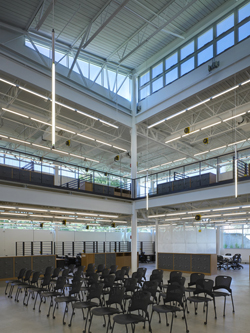
Sensors throughout the facility monitor occupancy and light levels and automatically turn lights on and off as needed. In part because of this, as well as occupancy sensors that adjust the temperature and ventilation when the space is not occupied, the King Pavilion is 42 percent more energy efficient than a code-compliant building.
"According to our energy model, the King Pavilion will save a little more than $22,000 per year in energy - about $1 per square foot - over a code baseline," said Michael Andresen, RDG intern architect and the LEED Accredited Professional on the project. "If you imagine ISU's millions of square footage and the potential of saving $1 per square foot, it begins to put into perspective the impact that sustainability can have on a larger scale."
The second exemplary performance point was for water efficiency. Thresholds in the LEED system range from 20 to 30 percent reduction in water usage over a code-compliant building. The King Pavilion achieved a 50 percent reduction, in part by installing dual-flush toilets in the restrooms. The two-button flushing system permits users to manually select the water volume of each flush according to need. Together with automatic sink faucets and low-flow urinals, this reduces the amount of water consumed by 50 percent over regular fixtures.
LEED thresholds for recycled content range from 10 and 20 percent; the King Pavilion achieved 32 percent, in part by using 75 percent recycled steel, recycled blue jean insulation, recycled plastics and restroom countertops made of 100 percent post-consumer recycled paper.
Commitment to green building
"This is truly an achievement for Iowa State. LEED Platinum is the most difficult certification to obtain, and we did it," said project manager Kerry Dixon-Fox, an architect with ISU facilities planning and management. "We used a number of new technologies on this building that haven't been used on campus before, and it will help us demonstrate how sustainable design provides a great learning environment. The King Pavilion will be a showcase for building green."
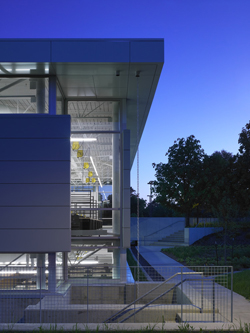
The King Pavilion is named for Steve King, Maple Plain, Minn., and his late wife, Barb, who made a commitment of $1.5 million for the facility. The Kings graduated from Iowa State in 1968 and founded Landscape Structures Inc., an innovative children's play equipment company that is an industry leader in safe, sustainable design practices. Their contribution to the pavilion project came from their own commitment to green design and the environment. In addition to the Kings, more than 2,000 alumni and friends contributed to the project.
"Not only did the College of Design as owner of the building want to have a sustainable project, but Iowa State as a whole is very focused on sustainability," Andresen said. "It's much easier to be innovative and push ideas that help the project be more sustainable when it's a priority for everyone."

